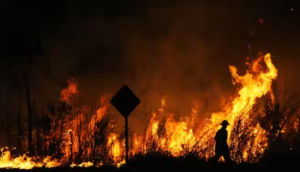
How Technology Supports Management of Natural Disasters
Managing natural disasters has grown more efficient and successful in a time marked by fast technical development. From early warning systems to real-time data analysis, technology is very essential in improving disaster readiness, response and recovery. This thorough manual explores the several ways in which technology helps to handle natural disasters, stressing important developments that affect community protection.
Technology’s Evolution of Disaster Management: Historical Viewpoint
Disaster management historically mostly depended on hand tools and crude techniques. Early warning systems were derived from observational data, and responses were constrained by the knowledge at hand. But as technology developed so did our capacity to forecast, get ready for, and react to natural calamities.
Contemporary Technological Revolutionaries
Technology nowadays has revolutionized disaster management in hitherto unheard-of proportions. Modern developments include artificial intelligence (AI), geographic information systems (GIS), and satellite images; all of which provide a more proactive and effective method of catastrophe management.
Early warning systems a technological wonder meteorological satellites
The creation of meteorological satellites is one of the most important technical developments in catastrophe management. These satellites give vital information on weather patterns, which lets meteorologists more precisely project natural calamities including typhoons, hurricanes, and tornadoes. These satellites provide early warnings based on atmospheric conditions from orbit that might save property or even lives.
Seismic Devices
Seismic sensors are absolutely important for both volcanic explosions and earthquakes. These sensors track seismic activity in real time and sense ground vibrations. By use of data analysis, scientists can provide early warnings and evaluate the possible effects of earthquakes and eruptions, therefore enabling people to be better prepared and responded for.
Systems of Tsunami Alertness
Undersea earthquakes often causes tsunamis, hence early warnings depend on the identification of these seismic events. Combining seismic sensors with ocean buoys, tsunami warning systems track variations in sea level and identify tsunami waves. By letting coastal towns receive warnings quickly, this technology helps to lower the danger of death and property damage.
Geographic Information Systems (GIS) map disaster hazards.
GIS stands for:
Powerful tools combining spatial data to produce thorough maps and analyses are Geographic Information Systems (GIS). GIS is applied in disaster management to evaluate hazards, create evacuation routes and organize reaction activities. GIS aids in decision-makers’ understanding of the possible impact of disasters and informed decision-making by seeing data in a geographical setting.
By means of historical data, topography, and land use analysis, GIS aids in the identification of places highly vulnerable for natural disasters. Developing plans to reduce hazards and safeguard underprivileged groups depends on this data.
GIS maps out impacted areas, finds emergency resources, and guides evacuation paths during a crisis. This guarantees aimed and effective reaction actions.

Following a disaster, GIS helps to evaluate the damage and organize for recovery. Pre- and post-disaster maps let authorities prioritize rebuilding and distribute funds wisely.
Drones: Aerial Data collecting and surveillance
The Emerging Drones
In disaster management, drones also known as unmanned aerial vehicles UAVs have become rather valuable instruments. Equipped with sensors and high-resolution cameras, drones offer real-time aerial images and data collecting capability. Disaster response and recovery activities find them perfect because of their adaptability and accessibility.
Damage Assessment: Drones can rapidly survey disaster-affected areas, offering comprehensive images that aids in damage assessment. Setting priorities for response activities and distributing resources depend on this knowledge.
Drones can help in search and rescue following a disaster by locating survivors and danger identification. Their capacity to reach places maybe unreachable on earth speeds up rescue operations.
Bridges, roads and power lines are among the important infrastructure sites drone inspections cover. This guarantees quick completion of repairs and helps to spot structural deterioration.
artificial intelligence (AI) and machine learning: disaster prediction and analysis
Artificial Intelligence in Disaster Prediction
Machine learning and artificial intelligence (AI) are transforming study and prediction of disasters. Processing enormous volumes of data allows AI systems to find trends and patterns suggesting the probability of a calamity. Early warning systems are improved and communities can get ready for possible hazards by this predictive capacity.
Applications of Machine Learning:
Machine learning models examine past weather data to raise forecast accuracy. Greater accuracy allows these models to forecast severe weather phenomena including storms and heat waves.
Artificial intelligence systems evaluate elements including river levels, soil moisture and rainfall to project flood hazards. Designing flood control systems and organizing evacuations benefit from this knowledge.
AI-powered simulations generate scenarios of possible calamities so that authorities may test reaction plans and raise readiness. These models improve general readiness and help to find flaws in emergency plans.
Social Media and Communication: Sharing Knowledge and Organization of Information
Real-Time Alerts
Social media channels now are crucial instruments for spreading knowledge amid natural disasters. Authorities may send real-time updates, issue warnings, and distribute safety tips using sites including Twitter, Facebook, and Instagram. Social media also helps people to report catastrophes and ask for help, hence improving communication during such events.
Organization and Cooperation
Good catastrophe management calls for cooperation amongst several agencies and companies. Technology helps with this by offering channels of communication and cooperative tools. Online tools and sites let responders track resources in real time, coordinate activities and distribute knowledge.
Mobile Technology: Getting Information on the Go Mobile Apps for Disaster Management
Mobile technology has changed how people obtain information connected to disasters. Real-time notifications, safety advice, and emergency contact data included in mobile apps give users These tools also let people document events and seek assistance, therefore facilitating the information gathering and action taking during a crisis.
Text messaging and alert systems
Emergency warnings and alerts sent to those living in impacted areas are text message based. These communications offer vital details on the type of the crisis, directions for evacuation, and safety precautions. The general use of mobile phones guarantees that these alarms reach a big audience fast.
Remote Sensing and Satellite Imagery: Tracking and Examining Natural Events from Above
The Authority of Satellite Visionary
Comprehensive perspective of disaster-affected areas made possible by satellite images enables thorough study and monitoring. High-resolution photos acquired by satellites expose environmental changes including land subsidence, flooding, and deforestation. Planning for recovery and evaluating the effect of disasters depend on this information.
Technologies of Remote Sensation
Radar and lidar among other remote sensing technologies add more data on surface conditions and changes, therefore augmenting satellite imaging. These technologies help us to better grasp the effects of disasters, monitor and evaluate them, so enabling efficient reaction plans.
Case Studies: Active Technology
Katrina, Hurricane: Knowledge Gained
The reaction to Hurricane Katrina in 2005 underlined the difficulties as well as the possibilities of technology for disaster control. Coordinating response activities and evaluating damage depended much on the usage of GIS and satellite images. Still, the event also highlighted how urgently agencies’ cooperation and communication need work.
The Australian Bushfires of 2019–2020
The Australian bushfires proved how well technology might be used in disaster control. Early warning systems, satellite monitoring, and drone surveillance provide vital data on fire behavior and made focused action possible. By means of these tools, the crisis was managed and additional damage was reduced.
Difficulties and Future Orientations
Technology Constraints
Although catastrophe management has been much improved by technology, problems still exist. Technical solutions’ effectiveness can be affected by problems including data accuracy, system dependability, and accessibility. Improving disaster management capability requires addressing these constraints.
Disaster Management Technology: Future Prospect
Disaster management technology has fascinating opportunities going forward. Remote sensing, machine learning, and artificial intelligence will keep improving prediction, monitoring, and reaction initiatives. Cooperation among disaster management experts, researchers, and technology developers will stimulate creativity and raise our capacity to control natural events.
In summary,
Technology is now a necessary tool for managing natural catastrophes since it transforms our predictions, preparation, reaction, and recovery from them. From early warning systems and GIS to drones and artificial intelligence, technology developments have greatly improved our capacity to protect populations and reduce the effects of natural disasters. Technology will surely become even more important as it develops in shielding property and lives from the terrible consequences of natural disasters.
By appreciating and developing these technical solutions, we get closer to a day when disaster management will be proactive rather than merely reactive, therefore guaranteeing a safer and more robust planet for next generations.